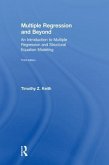Timothy Z. Keith, Matthew Reynolds, Jacqueline Caemmerer
Multiple Regression and Beyond
An Introduction to Multiple Regression and Structural Equation Modeling
Timothy Z. Keith, Matthew Reynolds, Jacqueline Caemmerer
Multiple Regression and Beyond
An Introduction to Multiple Regression and Structural Equation Modeling
- Gebundenes Buch
- Merkliste
- Auf die Merkliste
- Bewerten Bewerten
- Teilen
- Produkt teilen
- Produkterinnerung
- Produkterinnerung
Multiple Regression and Beyond offers a conceptually-oriented introduction to multiple regression (MR) analysis and structural equation modeling (SEM), along with analyses that flow naturally from those methods.
Andere Kunden interessierten sich auch für
![Multiple Regression and Beyond Multiple Regression and Beyond]() Timothy Z. KeithMultiple Regression and Beyond258,99 €
Timothy Z. KeithMultiple Regression and Beyond258,99 €![Researching Learning and Teaching with Adults Researching Learning and Teaching with Adults]() Ralf St. ClairResearching Learning and Teaching with Adults171,99 €
Ralf St. ClairResearching Learning and Teaching with Adults171,99 €![Wohlbefinden und Raumgestaltung an der Universität Wohlbefinden und Raumgestaltung an der Universität]() Katja MausWohlbefinden und Raumgestaltung an der Universität17,95 €
Katja MausWohlbefinden und Raumgestaltung an der Universität17,95 €![Visual, Narrative and Creative Research Methods Visual, Narrative and Creative Research Methods]() Dawn MannayVisual, Narrative and Creative Research Methods195,99 €
Dawn MannayVisual, Narrative and Creative Research Methods195,99 €![The Reviewer's Guide to Quantitative Methods in the Social Sciences The Reviewer's Guide to Quantitative Methods in the Social Sciences]() The Reviewer's Guide to Quantitative Methods in the Social Sciences272,99 €
The Reviewer's Guide to Quantitative Methods in the Social Sciences272,99 €![Qualitative Research in Education Qualitative Research in Education]() Marilyn LichtmanQualitative Research in Education148,99 €
Marilyn LichtmanQualitative Research in Education148,99 €![How to Write Qualitative Research How to Write Qualitative Research]() Marcus B. Weaver-HightowerHow to Write Qualitative Research166,99 €
Marcus B. Weaver-HightowerHow to Write Qualitative Research166,99 €-
-
-
Multiple Regression and Beyond offers a conceptually-oriented introduction to multiple regression (MR) analysis and structural equation modeling (SEM), along with analyses that flow naturally from those methods.
Produktdetails
- Produktdetails
- Verlag: Routledge
- 4. Auflage
- Seitenzahl: 712
- Erscheinungstermin: 30. September 2025
- Englisch
- Abmessung: 260mm x 183mm x 42mm
- Gewicht: 1511g
- ISBN-13: 9781032520957
- ISBN-10: 1032520957
- Artikelnr.: 73583548
- Herstellerkennzeichnung
- Libri GmbH
- Europaallee 1
- 36244 Bad Hersfeld
- gpsr@libri.de
- Verlag: Routledge
- 4. Auflage
- Seitenzahl: 712
- Erscheinungstermin: 30. September 2025
- Englisch
- Abmessung: 260mm x 183mm x 42mm
- Gewicht: 1511g
- ISBN-13: 9781032520957
- ISBN-10: 1032520957
- Artikelnr.: 73583548
- Herstellerkennzeichnung
- Libri GmbH
- Europaallee 1
- 36244 Bad Hersfeld
- gpsr@libri.de
Timothy Z. Keith is Professor Emeritus at the University of Texas, Austin. Before retiring he was director of the graduate school psychology program (now school and clinical child psychology) in the Department of Educational Psychology. His research focused on the nature and measurement of intelligence, including the validity of tests of intelligence and the theories from which they are drawn. Matthew R. Reynolds is Professor of Educational Psychology at the University of Kansas. His research focuses on the measurement and structure of human cognitive abilities and on sex differences in cognitive abilities and academic achievement. Jacqueline M. Caemmerer is an Assistant Professor in the Department of Educational Psychology (school psychology graduate programs) at the University of Connecticut. Her research interests are in psychological assessment and validity issues. She is interested in better understanding what frequently used tests measure, their predictive validity, and developmental and cultural considerations of tests.
Preface
Notes for the Fourth Edition
Acknowledgments
Part I: Multiple Regression
Chapter 1: Simple bivariate regression
Chapter 2: Multiple regression: Introduction
Chapter 3: Multiple regression: More detail
Chapter 4: Three and more independent variables and related issues
Chapter 5: Three Types of multiple regression
Chapter 6: Analysis of categorical variables
Chapter 7: Regression with categorical and continuous variables
Chapter 8: Testing for interactions and curves with continuous variables
Chapter 9: Mediation, moderation, common cause, and suppression
Chapter 10: Multiple regression: Summary, assumptions, diagnostics, power,
and problems
Chapter 11: Related methods: Quantile regression, logistic regression and
multilevel modeling
Part II: Beyond Multiple Regression: Structural Equation Modeling
Chapter 12: Path modeling: Structural equation modeling with measured
variables
Chapter 13: Path analysis: Assumptions and dangers
Chapter 14: Analyzing path models using SEM programs
Chapter 15: Error: The scourge of research
Chapter 16: Confirmatory factor analysis I
Chapter 17: Putting it all together: Introduction to latent variable SEM
Information Classification: General
Chapter 18: Latent variable models II: Single indicators, correlated
errors, multigroup models, panel models, dangers & assumptions
Chapter 19: Latent means in SEM
Chapter 20: Confirmatory factor analysis II: Invariance and latent means
Chapter 21: Latent growth models
Chapter 22: Latent variable interactions and multilevel modeling in SEM
Chapter 23: Summary: Path analysis, CFA, SEM, mean structures, and latent
growth models
Appendices
Appendix A: Data files and statistical program notes
Appendices B: Review of basic statistics concepts
Appendix C: Partial and semipartial correlation
Appendix D: Symbols used in this book
Appendix E: Useful formulae
Reference
Author index
Subject index
Notes for the Fourth Edition
Acknowledgments
Part I: Multiple Regression
Chapter 1: Simple bivariate regression
Chapter 2: Multiple regression: Introduction
Chapter 3: Multiple regression: More detail
Chapter 4: Three and more independent variables and related issues
Chapter 5: Three Types of multiple regression
Chapter 6: Analysis of categorical variables
Chapter 7: Regression with categorical and continuous variables
Chapter 8: Testing for interactions and curves with continuous variables
Chapter 9: Mediation, moderation, common cause, and suppression
Chapter 10: Multiple regression: Summary, assumptions, diagnostics, power,
and problems
Chapter 11: Related methods: Quantile regression, logistic regression and
multilevel modeling
Part II: Beyond Multiple Regression: Structural Equation Modeling
Chapter 12: Path modeling: Structural equation modeling with measured
variables
Chapter 13: Path analysis: Assumptions and dangers
Chapter 14: Analyzing path models using SEM programs
Chapter 15: Error: The scourge of research
Chapter 16: Confirmatory factor analysis I
Chapter 17: Putting it all together: Introduction to latent variable SEM
Information Classification: General
Chapter 18: Latent variable models II: Single indicators, correlated
errors, multigroup models, panel models, dangers & assumptions
Chapter 19: Latent means in SEM
Chapter 20: Confirmatory factor analysis II: Invariance and latent means
Chapter 21: Latent growth models
Chapter 22: Latent variable interactions and multilevel modeling in SEM
Chapter 23: Summary: Path analysis, CFA, SEM, mean structures, and latent
growth models
Appendices
Appendix A: Data files and statistical program notes
Appendices B: Review of basic statistics concepts
Appendix C: Partial and semipartial correlation
Appendix D: Symbols used in this book
Appendix E: Useful formulae
Reference
Author index
Subject index
Preface
Part I: Multiple Regression
Chapter 1: Simple Bivariate Regression
Chapter 2: Multiple Regression: Introduction
Chapter 3: Multiple Regression: More Depth
Chapter 4: Three and More Independent Variables and Related Issues
Chapter 5: Three Types of Multiple Regression
Chapter 6: Analysis of Categorical Variables
Chapter 7: Regression with Categorical and Continuous Variables
Chapter 8: Testing for Interactions and Curves with Continuous Variables
Chapter 9: Mediation, Moderation, and Common Cause
Chapter 10: Multiple Regression: Summary, Assumptions, Diagnostics, Power, and Problems
Chapter 11: Related Methods: Logistic Regression and Multilevel Modeling
Part II: Beyond Multiple Regression: Structural Equation Modeling
Chapter 12: Path Modeling: Structural Equation Modeling with Measured Variables
Chapter 13: Path Analysis: Assumptions and Dangers
Chapter 14: Analyzing Path Models Using SEM Programs
Chapter 15: Error: The Scourge of Research
Chapter 16: Confirmatory Factor Analysis I
Chapter 17: Putting It All Together: Introduction to Latent Variable SEM
Chapter 18: Latent Variable Models II: Multigroup Models, Panel Models, Dangers & Assumptions
Chapter 19: Latent Means In SEM
Chapter 20: Confirmatory Factor Analysis II: Invariance and Latent Means
Chapter 21: Latent Growth Models
Chapter 22: Latent Variable Interactions and Multilevel Models In SEM
Chapter 23: Summary: Path Analysis, CFA, SEM, Mean Structures, and Latent Growth Models
Appendices
Appendix A: Data Files.
Appendix B: Review of Basic Statistics Concepts
Appendix C: Partial and Semipartial Correlation
Appendix D: Symbols Used in This Book
Appendix E: Useful Formulae
Part I: Multiple Regression
Chapter 1: Simple Bivariate Regression
Chapter 2: Multiple Regression: Introduction
Chapter 3: Multiple Regression: More Depth
Chapter 4: Three and More Independent Variables and Related Issues
Chapter 5: Three Types of Multiple Regression
Chapter 6: Analysis of Categorical Variables
Chapter 7: Regression with Categorical and Continuous Variables
Chapter 8: Testing for Interactions and Curves with Continuous Variables
Chapter 9: Mediation, Moderation, and Common Cause
Chapter 10: Multiple Regression: Summary, Assumptions, Diagnostics, Power, and Problems
Chapter 11: Related Methods: Logistic Regression and Multilevel Modeling
Part II: Beyond Multiple Regression: Structural Equation Modeling
Chapter 12: Path Modeling: Structural Equation Modeling with Measured Variables
Chapter 13: Path Analysis: Assumptions and Dangers
Chapter 14: Analyzing Path Models Using SEM Programs
Chapter 15: Error: The Scourge of Research
Chapter 16: Confirmatory Factor Analysis I
Chapter 17: Putting It All Together: Introduction to Latent Variable SEM
Chapter 18: Latent Variable Models II: Multigroup Models, Panel Models, Dangers & Assumptions
Chapter 19: Latent Means In SEM
Chapter 20: Confirmatory Factor Analysis II: Invariance and Latent Means
Chapter 21: Latent Growth Models
Chapter 22: Latent Variable Interactions and Multilevel Models In SEM
Chapter 23: Summary: Path Analysis, CFA, SEM, Mean Structures, and Latent Growth Models
Appendices
Appendix A: Data Files.
Appendix B: Review of Basic Statistics Concepts
Appendix C: Partial and Semipartial Correlation
Appendix D: Symbols Used in This Book
Appendix E: Useful Formulae
Preface
Notes for the Fourth Edition
Acknowledgments
Part I: Multiple Regression
Chapter 1: Simple bivariate regression
Chapter 2: Multiple regression: Introduction
Chapter 3: Multiple regression: More detail
Chapter 4: Three and more independent variables and related issues
Chapter 5: Three Types of multiple regression
Chapter 6: Analysis of categorical variables
Chapter 7: Regression with categorical and continuous variables
Chapter 8: Testing for interactions and curves with continuous variables
Chapter 9: Mediation, moderation, common cause, and suppression
Chapter 10: Multiple regression: Summary, assumptions, diagnostics, power,
and problems
Chapter 11: Related methods: Quantile regression, logistic regression and
multilevel modeling
Part II: Beyond Multiple Regression: Structural Equation Modeling
Chapter 12: Path modeling: Structural equation modeling with measured
variables
Chapter 13: Path analysis: Assumptions and dangers
Chapter 14: Analyzing path models using SEM programs
Chapter 15: Error: The scourge of research
Chapter 16: Confirmatory factor analysis I
Chapter 17: Putting it all together: Introduction to latent variable SEM
Information Classification: General
Chapter 18: Latent variable models II: Single indicators, correlated
errors, multigroup models, panel models, dangers & assumptions
Chapter 19: Latent means in SEM
Chapter 20: Confirmatory factor analysis II: Invariance and latent means
Chapter 21: Latent growth models
Chapter 22: Latent variable interactions and multilevel modeling in SEM
Chapter 23: Summary: Path analysis, CFA, SEM, mean structures, and latent
growth models
Appendices
Appendix A: Data files and statistical program notes
Appendices B: Review of basic statistics concepts
Appendix C: Partial and semipartial correlation
Appendix D: Symbols used in this book
Appendix E: Useful formulae
Reference
Author index
Subject index
Notes for the Fourth Edition
Acknowledgments
Part I: Multiple Regression
Chapter 1: Simple bivariate regression
Chapter 2: Multiple regression: Introduction
Chapter 3: Multiple regression: More detail
Chapter 4: Three and more independent variables and related issues
Chapter 5: Three Types of multiple regression
Chapter 6: Analysis of categorical variables
Chapter 7: Regression with categorical and continuous variables
Chapter 8: Testing for interactions and curves with continuous variables
Chapter 9: Mediation, moderation, common cause, and suppression
Chapter 10: Multiple regression: Summary, assumptions, diagnostics, power,
and problems
Chapter 11: Related methods: Quantile regression, logistic regression and
multilevel modeling
Part II: Beyond Multiple Regression: Structural Equation Modeling
Chapter 12: Path modeling: Structural equation modeling with measured
variables
Chapter 13: Path analysis: Assumptions and dangers
Chapter 14: Analyzing path models using SEM programs
Chapter 15: Error: The scourge of research
Chapter 16: Confirmatory factor analysis I
Chapter 17: Putting it all together: Introduction to latent variable SEM
Information Classification: General
Chapter 18: Latent variable models II: Single indicators, correlated
errors, multigroup models, panel models, dangers & assumptions
Chapter 19: Latent means in SEM
Chapter 20: Confirmatory factor analysis II: Invariance and latent means
Chapter 21: Latent growth models
Chapter 22: Latent variable interactions and multilevel modeling in SEM
Chapter 23: Summary: Path analysis, CFA, SEM, mean structures, and latent
growth models
Appendices
Appendix A: Data files and statistical program notes
Appendices B: Review of basic statistics concepts
Appendix C: Partial and semipartial correlation
Appendix D: Symbols used in this book
Appendix E: Useful formulae
Reference
Author index
Subject index
Preface
Part I: Multiple Regression
Chapter 1: Simple Bivariate Regression
Chapter 2: Multiple Regression: Introduction
Chapter 3: Multiple Regression: More Depth
Chapter 4: Three and More Independent Variables and Related Issues
Chapter 5: Three Types of Multiple Regression
Chapter 6: Analysis of Categorical Variables
Chapter 7: Regression with Categorical and Continuous Variables
Chapter 8: Testing for Interactions and Curves with Continuous Variables
Chapter 9: Mediation, Moderation, and Common Cause
Chapter 10: Multiple Regression: Summary, Assumptions, Diagnostics, Power, and Problems
Chapter 11: Related Methods: Logistic Regression and Multilevel Modeling
Part II: Beyond Multiple Regression: Structural Equation Modeling
Chapter 12: Path Modeling: Structural Equation Modeling with Measured Variables
Chapter 13: Path Analysis: Assumptions and Dangers
Chapter 14: Analyzing Path Models Using SEM Programs
Chapter 15: Error: The Scourge of Research
Chapter 16: Confirmatory Factor Analysis I
Chapter 17: Putting It All Together: Introduction to Latent Variable SEM
Chapter 18: Latent Variable Models II: Multigroup Models, Panel Models, Dangers & Assumptions
Chapter 19: Latent Means In SEM
Chapter 20: Confirmatory Factor Analysis II: Invariance and Latent Means
Chapter 21: Latent Growth Models
Chapter 22: Latent Variable Interactions and Multilevel Models In SEM
Chapter 23: Summary: Path Analysis, CFA, SEM, Mean Structures, and Latent Growth Models
Appendices
Appendix A: Data Files.
Appendix B: Review of Basic Statistics Concepts
Appendix C: Partial and Semipartial Correlation
Appendix D: Symbols Used in This Book
Appendix E: Useful Formulae
Part I: Multiple Regression
Chapter 1: Simple Bivariate Regression
Chapter 2: Multiple Regression: Introduction
Chapter 3: Multiple Regression: More Depth
Chapter 4: Three and More Independent Variables and Related Issues
Chapter 5: Three Types of Multiple Regression
Chapter 6: Analysis of Categorical Variables
Chapter 7: Regression with Categorical and Continuous Variables
Chapter 8: Testing for Interactions and Curves with Continuous Variables
Chapter 9: Mediation, Moderation, and Common Cause
Chapter 10: Multiple Regression: Summary, Assumptions, Diagnostics, Power, and Problems
Chapter 11: Related Methods: Logistic Regression and Multilevel Modeling
Part II: Beyond Multiple Regression: Structural Equation Modeling
Chapter 12: Path Modeling: Structural Equation Modeling with Measured Variables
Chapter 13: Path Analysis: Assumptions and Dangers
Chapter 14: Analyzing Path Models Using SEM Programs
Chapter 15: Error: The Scourge of Research
Chapter 16: Confirmatory Factor Analysis I
Chapter 17: Putting It All Together: Introduction to Latent Variable SEM
Chapter 18: Latent Variable Models II: Multigroup Models, Panel Models, Dangers & Assumptions
Chapter 19: Latent Means In SEM
Chapter 20: Confirmatory Factor Analysis II: Invariance and Latent Means
Chapter 21: Latent Growth Models
Chapter 22: Latent Variable Interactions and Multilevel Models In SEM
Chapter 23: Summary: Path Analysis, CFA, SEM, Mean Structures, and Latent Growth Models
Appendices
Appendix A: Data Files.
Appendix B: Review of Basic Statistics Concepts
Appendix C: Partial and Semipartial Correlation
Appendix D: Symbols Used in This Book
Appendix E: Useful Formulae








